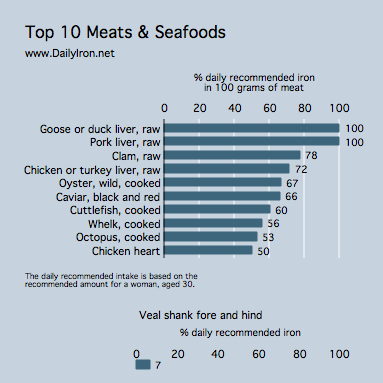Veal shank contains 1.2 milligrams of iron per 100 grams. Grams is a measure of weight. To put 100 grams in perspective, consider alternative measures for this food:
- 1 piece equals 194 grams.
- 3 oz equals 85 grams.
In the category of meat, we included whole food products in the Top 10 list. Processed foods may be fortified with iron but are not included in this Top 10 list.The food tested for the particular graph below can be described more specifically as:
Veal, shank (fore and hind), separable lean and fat, cooked, braised
Read more about iron in meat or visit our iron-rich foods list.

Meat as a class is an excellent iron food, particularly red meat. Red meat gets its redness from the large quantity of iron. People who enjoy red meat do not usually have low iron. If you do eat red meat and have an iron deficiency, consult with your doctor about your circumstances because you may have complicating issues, from your digestion to high levels of blood loss.
All meats have a further benefit of assisting your body to metabolize extra iron from non-meat sources. Vegetarian-based iron is usually bound in iron inhibitors, making that iron much more difficult to absorb. A minimal bit of meat can allow your body to absorb that iron and move it into your blood where you can actually use it. Learn more about meat’s role in iron absorption in this scientific study.
Veal Casserole
Veal Casserole
Put in a casserole dish cooked veal cut in slices. Saute 12 button onions in butter until golden brown. Add to the casserole with one cup of tomatoes, one cup of stock, one-half cup of celery cut in strips, one teaspoon salt and 1/8 teaspoon pepper. Cover and bake for one hour and then add two cups of potato cubes and cook until the potatoes are soft. Thicken the gravy with three tablespoons of flour mixed with three tablespoons of water. Add one cup of cooked string beans or peas and serve when hot.